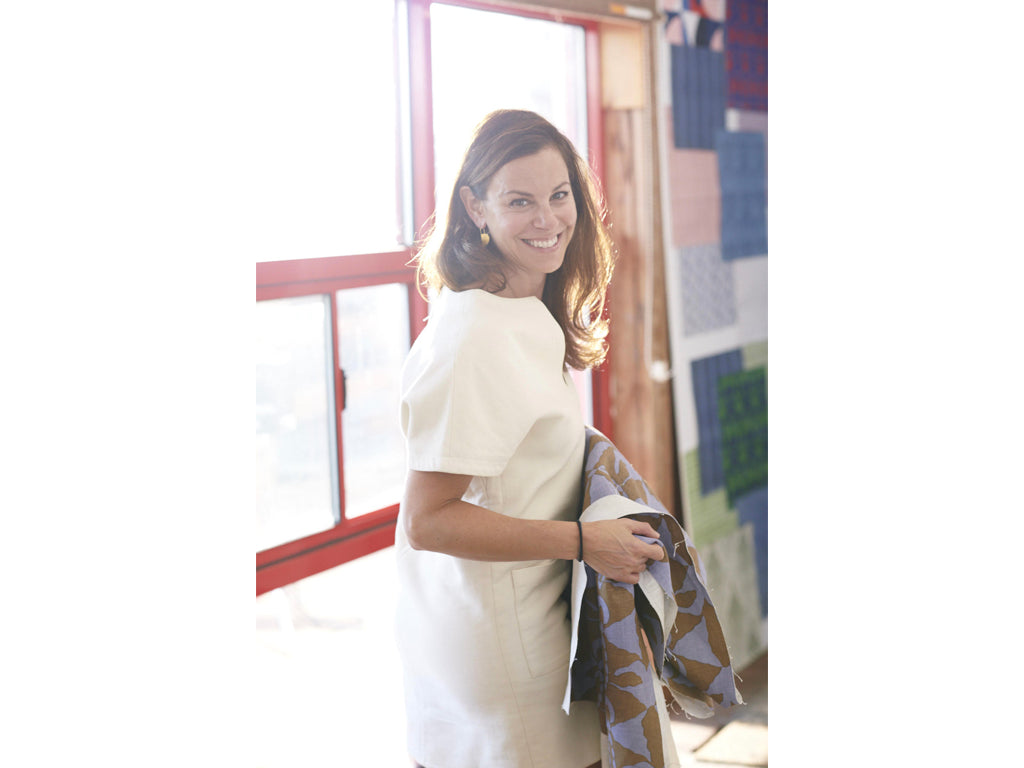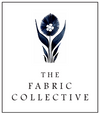DESIGNER DIARIES | 10 Questions with Serena Dugan

What is your earliest memory of design? When did you first know that you wanted to become a fabric/wallpaper designer?
My earliest memories of design are stunningly vivid, and are really focused on art/design. I have a clear-as-a-bell-memory of being out in the garage of our house in Austin, Texas with my grandmother, who was a professional artist. She was visiting from California, painting us a giant abstract painting for our living room. I was three or four and stayed strapped into a car seat on the garage floor as I directed her on what colors to paint where next. I was the conductor and she was my instrument. I treasure that painting and experience as my entry-point to creativity in my life.

Can you tell us about your journey to becoming a fabric designer? Did this start from prior experience as an Interior Designer?
My journey to becoming a fabric designer actually took this path: After Art School in my early 20s, I began my creative career as a decorative painter. I worked with residential clients, and eventually hotels and restaurants to create and paint bespoke patterns in spaces. Each pattern was distinct, but held together with what became my signature style. After seven years happily engaged with this work, I became intrigued by the notion of replicating my mark and producing my patterns on a larger scale, and went back to school to study textile design and printmaking.
In 2000, I created my first fabric line under the very same name - Serena Dugan Studio. It was a tight collection of prints that I block-printed by hand in my California studio. I sold fabric through interior designers across the state, and pillows through retailers.
In 2003 my work caught the eye of a boutique owner in nearby Mill Valley, CA and after a short but passionate conversation about what was missing from the market, she and I partnered to form a bedding company based around these textile prints called “Serena & Lily.” Serena & Lily grew rapidly to include a full range of home decor, including rugs, upholstery, furniture, lighting, accessories, and bedding. I ran the creative side of the business as Chief Creative Officer and Lead Textile Designer until 2017.
At this point I felt an increasingly strong calling to return to my studio roots, and pull away from the growingly commercial focus of a retail home business. Initially I focused on painting, and rather quickly vivid and vibrant textile ideas came into view. I decided to pull these ideas together in the form of a fabric and wallpaper collection, now sold through The Fabric Collective. My studio work includes my textile collection, sold through design showrooms, and paintings, sold through galleries. I consider both my art-forms as equally vital forms of my expression.
Where do you find the inspiration for your designs? What would you say are the main influences on your work?
My inspiration comes from both the loftiest and most mundane of sources! That’s the funny thing about inspiration — it can strike anywhere if you just learn to pay attention. That said, my strongest inspiration source is travel. New sights and smells and sounds and horizon lines create the conditions to see with fresh eyes, to make creative connections that you haven’t made before. Eye candy like tribal garb in South America, vintage textile treasure troves in India, the creative energy of Mexico City, the flea markets in the South of France — the world and its many pockets of visual richness never cease to inspire...unless of course a pandemic forbids it.

Collage for the Capri Fabric Design available in Capri Quartz | Capri Prussian Blue | Capri Sand/Ink
Where is the most surprising place that you’ve found inspiration for your designs?
If travel to faraway places are my lofty sources for inspiration, then my mundane come from surprises in my day-to-day. One such example that I can remember (although there are many) was the swimming pool with my kids a couple summers ago. I should have been watching them, but got distracted by the way slatted chair looked against the large black circle behind it, and how the table entered the frame just so. It was a gorgeous, balanced composition and it struck me enough for me to sketch it on whatever paper I could find and turn it into a painting shortly thereafter.
Inspiration strikes when you stay open to accidental beauty. As artists, designers and creators our job is to notice these harmonies.
Collage for the Cassis Wallpaper Design available in Cassis Grasscloth Dove/Natural Wallpaper | Cassis Grasscloth Sangria/Natural Wallpaper | Cassis Grasscloth Camel/Natural Wallpaper | Cassis Grasscloth Prussian Blue/Natural Wallpaper
Collage for the Sumba Wallpaper Design available in Sumba Grasscloth Umber/Natural Wallpaper | Sumba Grasscloth Adriatic/Natural Wallpaper | Sumba Grasscloth Moon/Natural Wallpaper
What’s your creative process? Take us through the development of a design from idea conception to the final product.
My creative process can take a multitude of directions, but most typically starts loose, with sketching. It might be a sketch of an arrangement, or shapes, or a motif. I will pretty quickly know if the sketch should be explored more and if so, if it wants to be explored as pattern or a painting. Pattern allows me to play with white space and rhythm, and artwork allows me to emphasize composition, layering and brushwork. They are different tracks.
If I go the direction of pattern, I will paint variations of repeat elements using gouache on bristol board. I then scan these elements and manipulate the arrangements in Photoshop. The exploration that happens in Photoshop, both with layout and color, is the most intensive and creative part of the textile design process. Those refinements make or break the success of the print.
Once the design “croquis” (idea) is approved, I put it into repeat so that the pattern meets up with itself seamlessly. It gets prepared to become a silkscreen, or several screens, depending on the number of colors in the print. Once the screens are burned, the printer creates a “strike-off” to sample the colorized print. Once I approve this strike-off, the yardage gets printed by hand, 30 yards at a time (the length of the table).
What types of materials and production processes do you prefer to use and why?
I am a stickler for fine fabrics and production methods that are as close to artisanal as possible. I use Libeco Belgian Linen as my base goods, because they are hefty and exquisite. I put so much care into designing my prints — I cannot consider wasting that effort by printing onto so-so goods. Libeco is the best.
I print by hand in Los Angeles, with a printer who has been in the business for many decades. He is as fanatical about quality as I am, and that gives me great comfort. I believe in handmade goods. It takes the idea from artist, to artisan, to client without breaking that human chain. There is a great deal of attention paid to the product from start to finish, and this keeps a great deal of soul in what I make.

The Serena Dugan Studio
What is something that most people don’t understand or appreciate about textile design that you wish they did?
What advice would you give to someone who wants to experiment with adding more colour and pattern to their interiors with fabric/wallpaper but is scared of making the wrong choice?
My advice to the color/pattern-tentative out there is that safe choices result in mediocre satisfaction. Safe looks, well, nice. Daring to make a bolder call by choosing a go-for-it print or colorway that creates an emotional reaction allows for something loftier: dynamism in your space and elation for you. Is it riskier? Yes. But mitigate that risk by sampling to whatever degree possible. Chances are if you love it (and color and pattern can do that), it’s the right answer, and it will become your favorite space in your home.

From Left to Right: Bahia Grasscloth Midnight/Blue Wallpaper | Cassis Grasscloth Prussian Blue/Natural Wallpaper | Cassis Grasscloth Dove/Natural Wallpaper | Bahia Grasscloth Onyx/Natural Wallpaper
Is there a particular design in your collection that’s your favourite and if so, why?
I have a connection to all the prints in my collection, but if pressed to choose a favorite I would have to say it’s my Condesa print. I designed Condesa after standing back from the collection once I thought I was finished designing, and realizing that it didn’t yet have one of my signatures, which is a shock of bold color. Condesa represents my painting style, and includes my love of bold color pairings. I was convinced that this print was necessary to express my point-of-view, but too out-there to be a big seller, yet it has become one of my top-selling patterns in the U.S.

From Left to Right, Top to Bottom: Condesa Midnight/Cherry | Condesa Mushroom/Peony | Condesa Peacock/Lime | Condesa Surplus/Lilac
How has the fabric and textile industry evolved since you became a part of it and what do you see and hope for the future of it?
My dream when I entered the industry 20 years ago was for independent textile artisans to have a venue for their craft, and for textile design to see a resurgence as an art form. The industry looked entirely different back then. Large scale manufacturing and big names dominated the market, and there was no entry-point for the independent textile designer.
Sure enough, now the market has shifted and the industry is honoring textiles as art-and-craft. Small scale textile designers can share the same stage as the large fabric houses. Showrooms like The Fabric Collective are giving a platform to these designers, artists and artisans and putting soul back into the textile industry. And interior designers are supporting the independents.
In the future I’d love to see this expand. We should connect to the story behind what we buy. Who made it? How? Why? What inspired it? When we ask these questions we connect to our products, give our “things” more value, and honor the people behind them. These objects then imbue our homes with meaning and resonance, and add quality to our experience. This is my wish. I do believe we’re on this trajectory.

Click to see Serena Dugan's Designer Profile and explore her fabric and wallpaper collections.


